Taxes in Denmark
Denmark's tax system
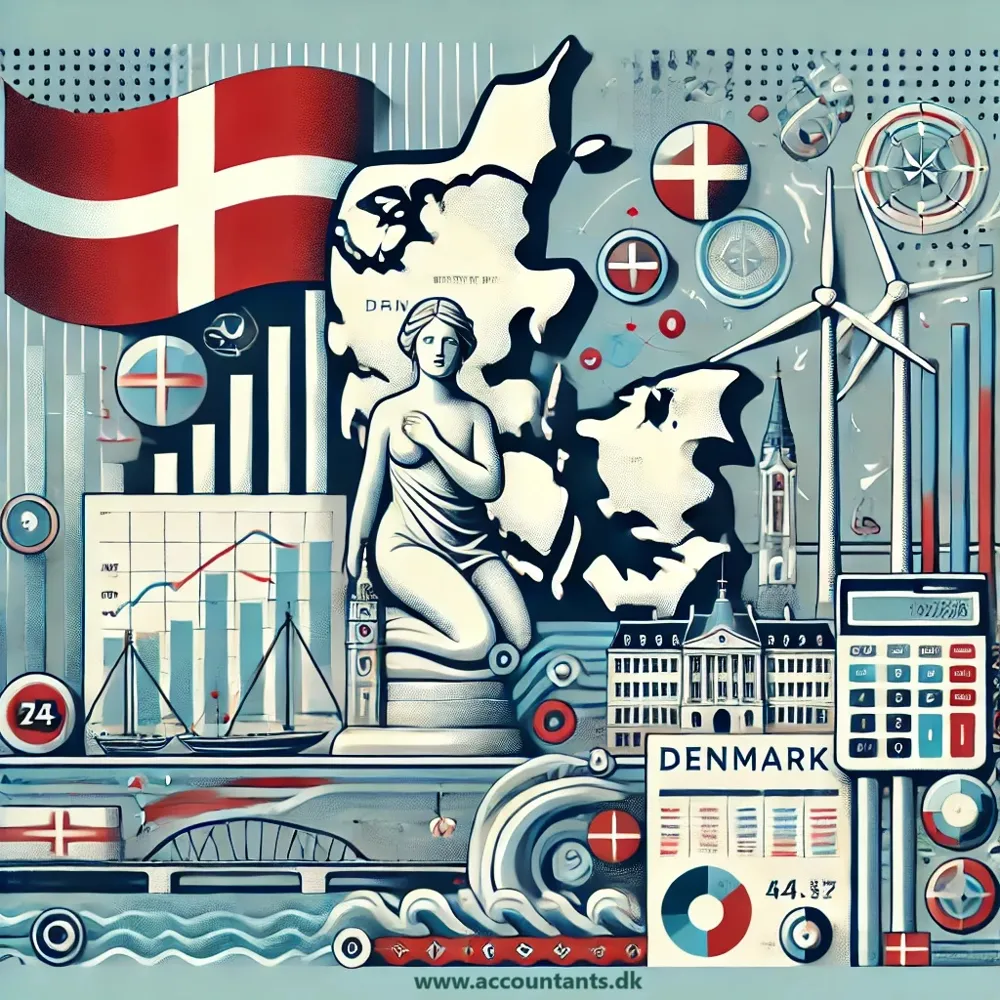
In the Kingdom of Denmark, taxation is distinguished by a significant rate and the ability to adjust to the income of companies and individuals in a gradual manner. The ability to deduct various expenses, such as pension or insurance premiums, alimony, food expenses or commuting costs from home to work, is available. The Danish Tax Authority (SKAT) has up to seven years to audit and verify these expenses.
There are different tax rates in Denmark, which depend on the status of the entity, such as employee of a Danish company, sole proprietor, company president or shareholder.
Key tax information in Denmark includes:
- Income taxes for 2019 are presented as follows:
- 8% for income below DKK 50,217,
- 39.2% for income between DKK 50,217 and DKK 558,043,
- 56.5% for income above DKK 558,043.
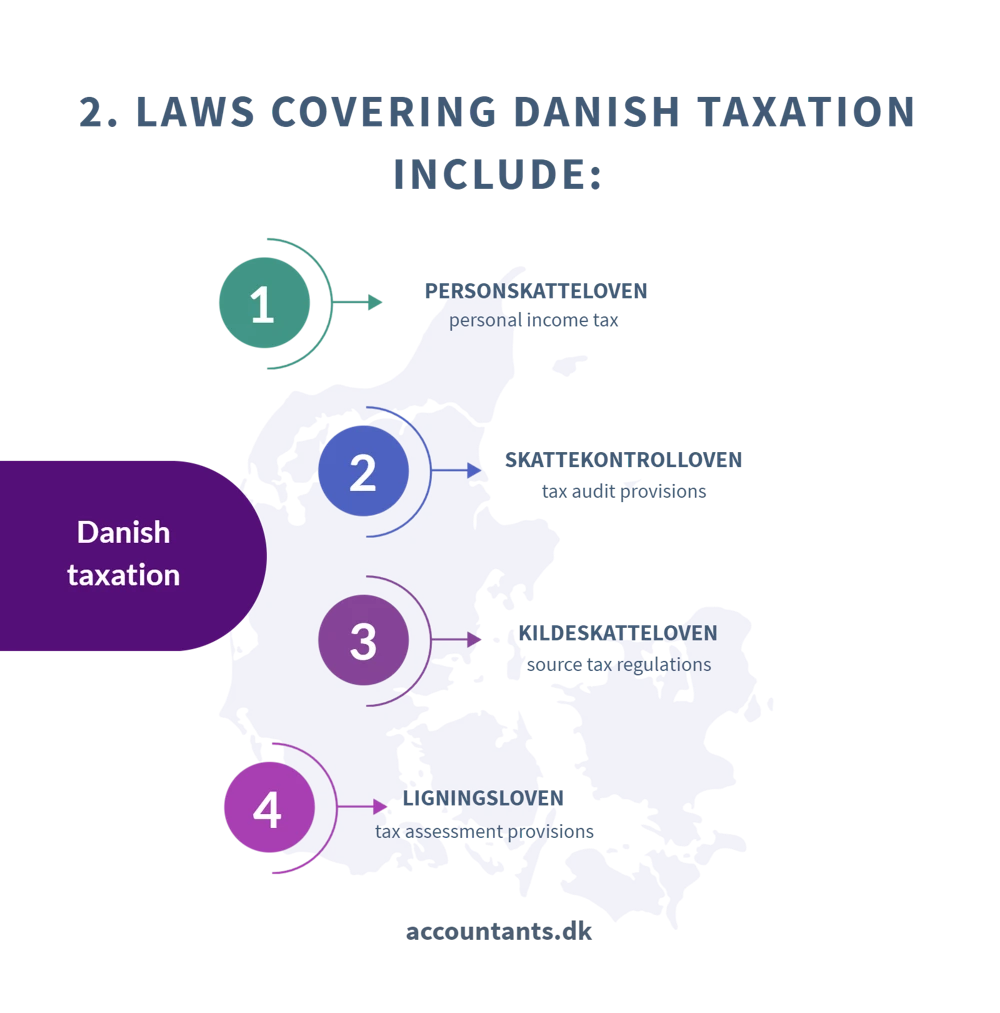
- The taxable allowance consists of state tax, city tax, health insurance premiums (sundhedsbidrag) and contributions to the labor market (arbejdmarkedsbidrag or AM-bidrag). The voluntary church tax is worth about 0.92%.
- Danish municipal tax, paid to local authorities, averages 24.92%.
- The process of registering with the regional Customs and Tax Administration is through the Agency for Enterprise and Trade.
- Taxation related to income from joint stock companies is 27% (up to DKK 54,000) or 42% (above DKK 54,000).
- When a company operates in Denmark, corporate tax is 22% CIT. However, if its annual turnover is more than DKK 50,000, it becomes liable for 25% VAT.
- For exports of goods and services, the VAT rate is 0%, and purchasers can deduct the tax upon purchase.
- The accounting period in Denmark coincides with the calendar year. Income for the previous calendar year (or other 12-month period) is taxed.
- Employees of Danish companies are subject to full or limited tax liability (begrænset skattepligt), depending on their contract and place of residence.
- The obligation to file a tax return with the Danish Tax Authority (SKAT) lasts for 3 years.
- In 2019, the tax exemption threshold was DKK 46,630. This means that people whose income was lower were not taxed.
- Danish tax returns must be filed online within 6 months of the end of the tax year. If the year ends between February 1 and March 31, the return must be filed by August 1, and tax must be paid by March 20 and November 20.
- The tax system in Denmark includes:
- church tax (kirkeskat),
- municipal tax (kommuneskat),
- pension contributions (ATM),
- employee contributions,
- health insurance premiums (sundhedsbidrag),
- land tax (on real estate) - Ejendomsværdiskat, applicable to all residents of Denmark. Applies to real estate, regardless of location. Rates are 1% up to a value of DKK 3.04 million and 3% above that amount,
- a tax on the value of real estate, assessed through a public valuation process,
- a tax on hiring foreign workers, imposed on Danish companies that hire non-Danish workers, at 38% - 35.6% net, including an 8% contribution to the employment fund and a 30% tax on hiring labor, paid to the Danish Tax Office,
- income tax, in both individuals and corporations,
- source tax, deducted from income,
- as well as indirect taxes: customs duties, environmental taxes, excise taxes (punktafgift), VAT (moms).
The Danish taxation system is complicated, so it is worthwhile to become thoroughly familiar with the regulations, rates, documents and deadlines related to taxation before starting a business or working in Denmark.
Taxation from a corporate perspective

In Denmark, the taxation system covers those located and earning in the country. Regardless of status, whether unemployed using a-kasse, pensioners, students with state subsidies, those working abroad with foreign income, or various forms of entrepreneurs such as sole proprietorship (Enkeltmandsvirksomhed), joint stock company (Aktieselskab - A/S), general partnership (Interesselskab - I/S), limited liability company (Anpartsselskab - ApS, also known as Danish Ltd), limited partnership (Kommanditselskab - K/S), branch of a foreign company (Filial af udenlandsk selskab), representative office of a foreign company (Salgskontor) or cooperative associations (Andelsforening/Brugsforening). (illustration)
In Denmark, the tax authority known as SKAT treats self-employment business income as income of the business owner. As a result, business taxation is reported through a single tax return. The business owner, who pays taxes and contributions, is entitled to pension and health benefits, as are employees employed in Denmark.
Every six months or quarter, it is necessary to submit a tax return via the SKAT online platform, covering both income tax and VAT. For income tax, advance payments are due on two dates: March 20 (if one opts for a higher advance payment, there is the possibility of getting a tax refund with interest that exceeds the bank's) and November 20 (in this case, the interest rate is reduced by 0.4 percentage points, which means lower interest compared to the bank).
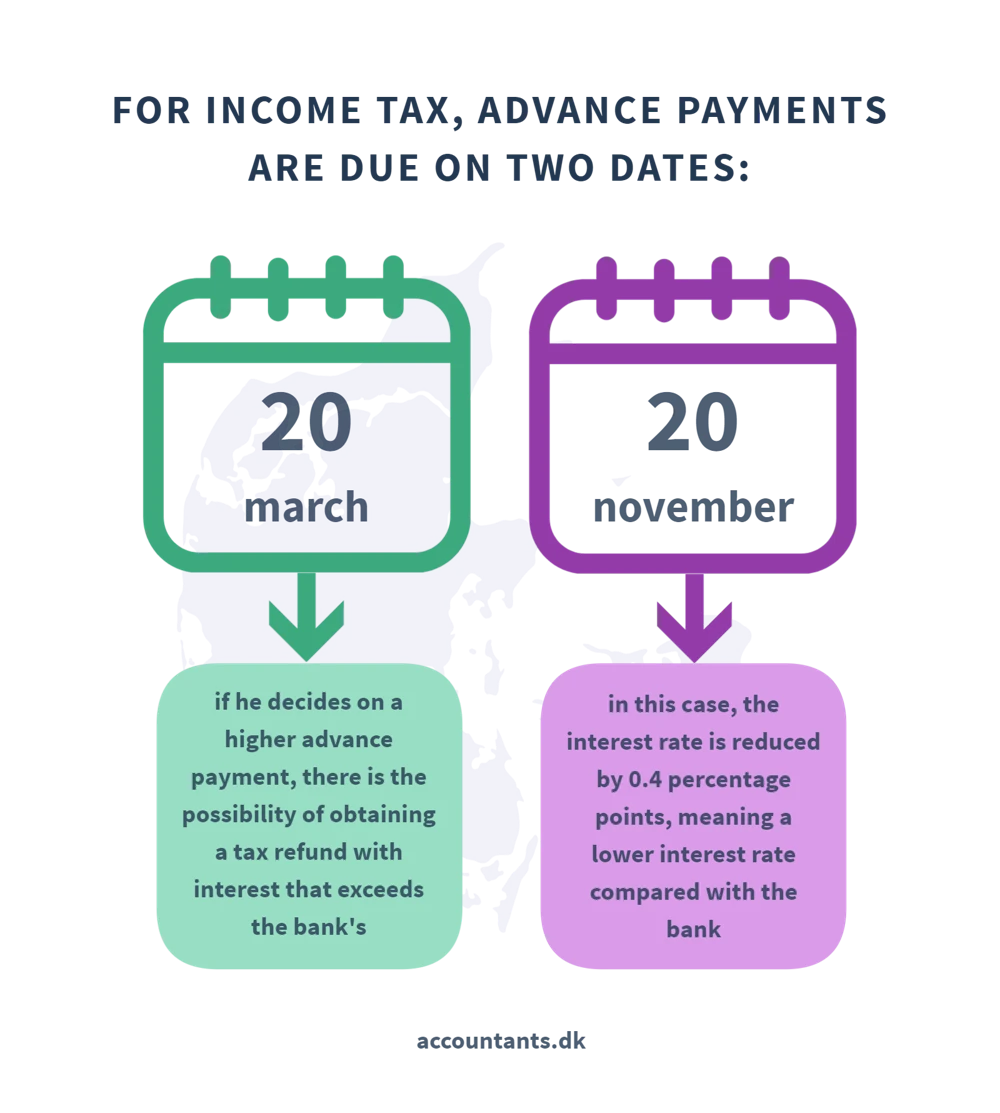
When someone sets up and runs a company in Denmark, a corporate tax of 22% applies. If the annual turnover of a Danish company exceeds DKK 50,000, the company becomes liable for VAT at 25%.
Danish tax thresholds
There are three levels of taxation in Denmark:
- Earnings up to DKK 50,217 are subject to an 8% rate,
- earnings between DKK 50,217 and DKK 558,043 are taxed at 39.2%,
- earnings in excess of DKK 558,043 are taxed at 56.6%, one of the highest rates in Europe.
Payment of taxes by companies
All corporate organizations operating in Denmark, from associations to cooperatives to limited liability companies, joint stock companies and foreign branches, are required to settle income tax on their general income (which includes both property and capital income) within six months after the end of the tax year.
What is worth understanding about this corporate entity taxation system?
- Income tax for corporations is 22%.
- Non-resident companies are taxed at 22% on income only for income generated in Denmark.
- The same 22% tax rate also covers capital gains that are included in the income of a company operating in Denmark.
- Capital gains related to the sale of company shares, group shares, portfolio shares and shares of subsidiaries are not taxable as long as you are a Danish shareholder.
- The complete capital gain from the sale of listed portfolio shares is subject to 22% tax.
- When a foreign shareholder sells shares in a particular company in Denmark, the capital gain from the said transaction is not subject to these specific taxes.
- All local companies are required to pay environmental taxes if they operate in the energy sector, and the process of settling these taxes takes place with the respective Tax Office.
- Income generated by corporate headquarters in Denmark is matched against the income of foreign subsidiaries (however, profits from these foreign subsidiaries may be exempt from taxation in Denmark).
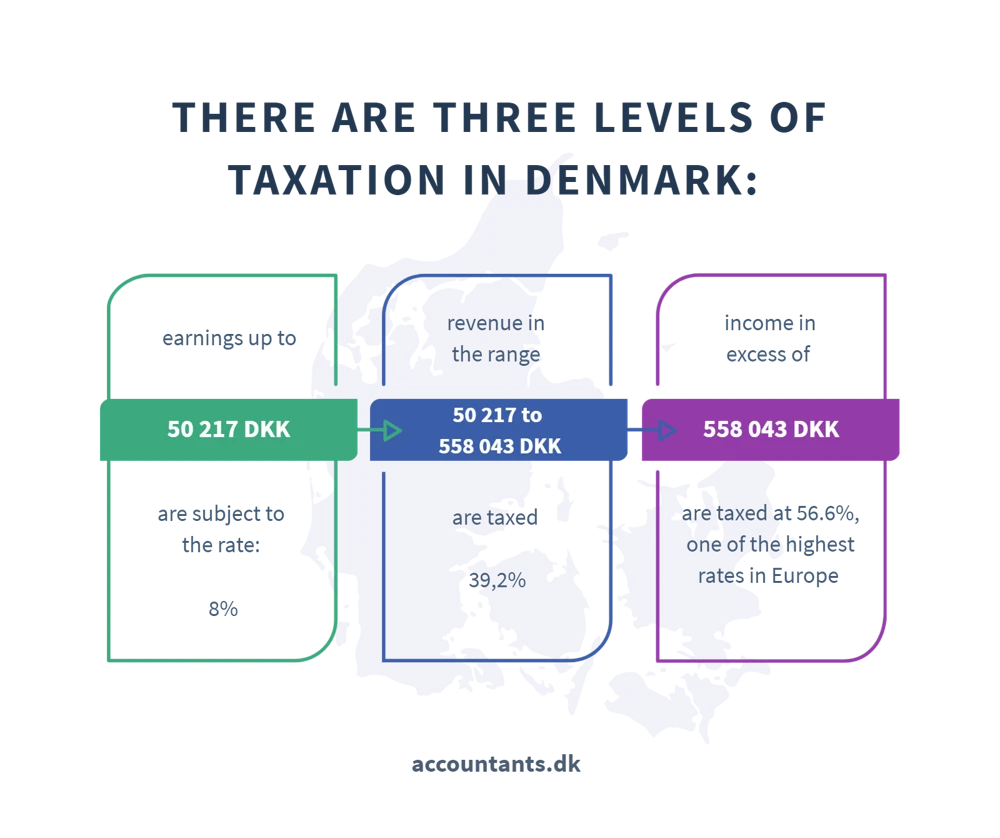
EU worker employed in Denmark
In the context of the free movement of workers within the European Union countries, there are no specific requirements to obtain approval for employment in Denmark. Nevertheless, there is an obligation to register with local social security and tax authorities.
An example is the situation of Pedro, a consultant from Spain, who received an attractive job offer from a Danish end client through Company A. After sending in his application, he was offered a project lasting six months, where full-time employment in Denmark was required. Pedro, a consultant, entered into a contract based on an hourly/daily wage, and his qualifications were accepted by the client. Under this contract, Pedro works in Denmark according to the agreed terms between Company A and the client.
From his first day on the job, Pedro, a German consultant, is required to pay taxes in Denmark, following the rules for international hiring. If Pedro decides to sever his ties to Spain, such as his residence, family or economic interests, and focus solely on working in Denmark, he will be subject to limited tax liability in this country.
Avoidance of double taxation
With the help of double taxation avoidance agreements, organizations aim to avoid situations where taxes are paid twice. Through international agreements between Denmark and various countries, taxes collected in an employee's country of employment can be reduced by the amount of tax they must pay in their country of residence. Income earned by employees in the country of employment is taxed only once (in that country), while it is excluded from taxation in the country of residence or registration (citizens are required to pay tax in the country with the higher tax rate). The formation of these agreements plays an important role in eliminating double taxation.
VAT
Denmark has a uniform VAT (MOMS) of 25%, which applies to both goods and services. However, there are some exceptions where certain services are exempt from this tax, such as:
- travel services,
- services related to funeral arrangements,
- social benefits,
- medical care,
- financial operations,
- insurance,
- artistic fields and culture,
- charitable activities,
- real estate transactions,
- sports fields,
- games,
- passenger transportation,
- postal fees.
It should be noted that despite the 25% VAT rate, there is also a zero rate (0%), which applies to exported goods and services. Purchasers of these goods and services are allowed to deduct the value of this tax.
In addition, certain services are subject to the reverse charge mechanism, such as:
- construction work,
- entertainment,
- conferences,
- employee leasing,
- exhibitions,
- maintenance and repair work,
- sports events,
- cleaning.
Additional relevant information regarding this tax is:
- All Danish companies with an annual turnover of more than DKK 50,000 are subject to VAT.
- The standard VAT rate is 25%.
- The 25% rate covers virtually all industrial services and products.
- Some services, such as medical care, education, cultural activities and banking, are subject to a 0% rate.
- Non-Danish workers employed for a period of 3 months to 3 years, earning at least DKK 47,500, are subject to 25% income tax and a 9% labor market contribution.
- Businesses selling products and services in Denmark are required to pay a uniform 25% VAT, which is added to the price of the final product or service.
- Registration of a company as a VAT payer must be done within 8 days of starting operations and can be done through the Registry of Foreign Suppliers portal (RUT, virk.dk).
- The reverse charge mechanism allows foreign companies to supply services and goods to Denmark without charging Danish VAT. In this case, the net value of the goods or services is shown on the invoice.
- Foreign companies, even if they are not VAT payers in Denmark, can claim a refund of taxed VAT for costs incurred in Denmark.
- Recipients of services in Denmark, even if they are not registered as VAT payers, are required to register and pay VAT.
CIT tax
The CIT tax is one of Denmark's key sources of government revenue, bringing in about 8% of total revenue. Its function is to tax the profits of companies operating in the country, also covering income from capital investments.
Here is some important information related to the tax in question:
- The corporate income tax rate is 22%.
- Legal entities, such as joint stock companies or private limited companies in Denmark, are subject to CIT. However, in the case of partnerships, only the partners of these companies are taxed.
- Denmark uses a system of consolidation of company taxation. This means that the tax is imposed on the parent Danish company, its branches and subsidiaries.
Excise tax
In Denmark, excise tax is imposed in accordance with European Union guidelines and in accordance with national regulations. It applies to various categories of goods, such as alcohols (wine, beer), cigarettes, natural gas, chocolate, electricity, chewing tobacco, coffee, car tires, confectionery and many others.
The duty calculation is based on the customs value of the product, taking into account the invoice price and transportation and insurance costs. Excise duty rates in Denmark vary, covering various product groups, such as tobacco products, alcohol, coffee, chocolate products, spirits, videotape, automobiles, fuel, light bulbs, ice cream, disposable packaging and others.
Tax-free amount
In 2019, Denmark adopted a rule that those working in Denmark whose annual income in that period did not exceed DKK 46,630 were not required to pay income tax for that year.
We also recommend reading our article on accounting in Denmark.
Tax levied on employees
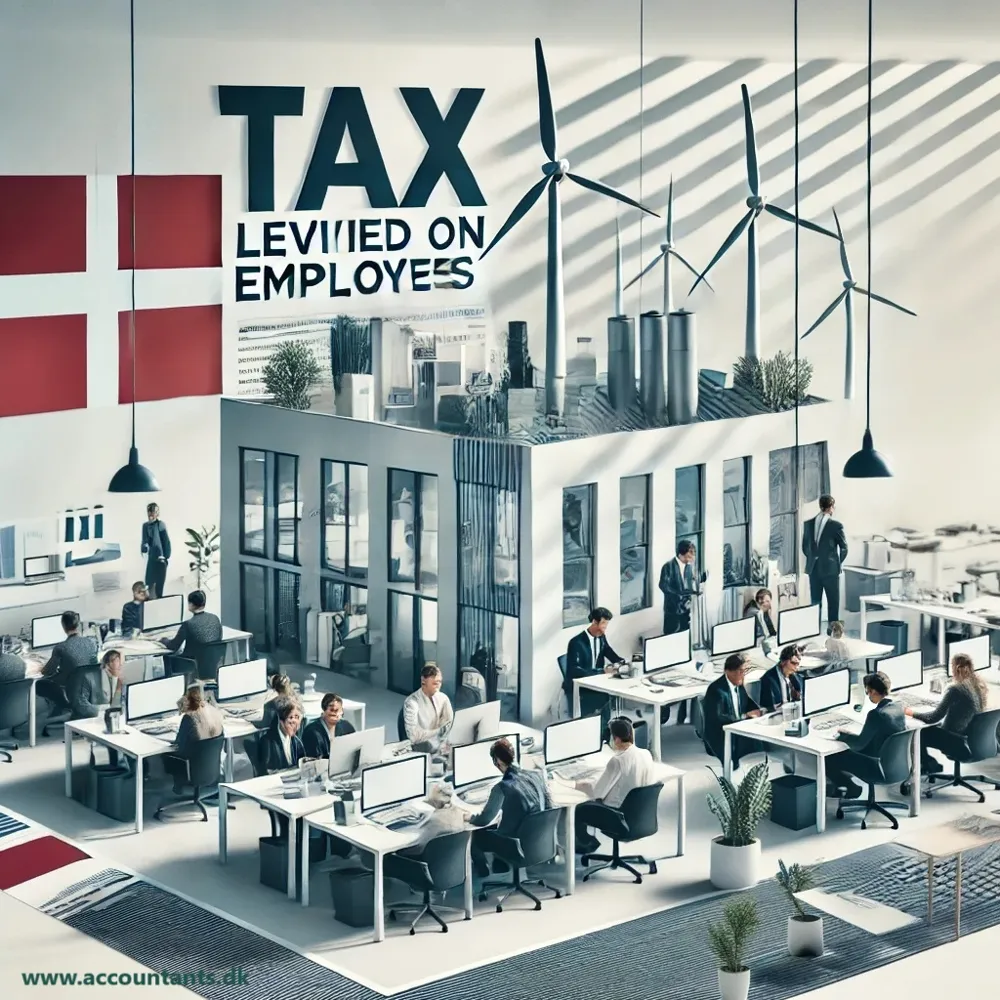
The Kingdom of Denmark has a system of income taxation that consists of three thresholds: low, medium and high. In the context of individuals, it is stipulated that a fixed income tax (to the municipality) is paid, amounting to 32.6%. In addition, there is a progressive income tax of 5.64% (on income above DKK 42,000, including capital gains), and 15% (for income above DKK 42,100, including capital gains). These fees contribute to the state budget. The progressive rate applies to both labor income and capital gains, but the total taxation on a single person's income will not exceed 59%.
In Denmark, individuals who are at least 15 years old (as well as younger income earners) are required to file a tax return at the end of each tax year. The deadline for this is July 1, except in cases where the taxpayer has requested an extension. In a situation where an individual does not earn income or only earns income from gainful activity in Denmark, he or she is required to file a simplified tax return by May 1. In the situation of married couples, the couple is required to file a separate income tax return.
Income tax
The Kingdom of Denmark, since 1903, has had a system of income taxation that is divided into two main categories: progressive state tax and flat local income tax.
In 2019, income tax percentages in Denmark are as follows:
- 8% for earnings below DKK 50,217.
- 39.2% for earnings between DKK 50,217 and DKK 558,043.
- 56.5% for earnings exceeding 558,043 Danish kroner.
The Danish area also has the option of voluntarily filing a church tax, which averages 0.92% (kirkestat rates can range from 1% to 2%, depending on the local municipality). In addition, there is a mobile municipal tax (kommuneskat), which averages 24.84% and is remitted to local governments.
A new tax exemption amount is set each year in Denmark (in 2019 it was 10.10% on gross wages).
Individuals who are subject to tax in Denmark are also required to register with the local tax office and the Trade and Companies Authority through the Danish Commerce and Companies Agency.
Necessary documents and important deadlines related to paying taxes
In the context of tax paperwork in Denmark, we encounter a variety of papers, and here are some of them:
- Arsopgorelse is an official document, prepared by SKAT, which is sent out after July 2 and contains key tax information, such as the final balance to be paid or refunded.
- Oplysningsseddel is the equivalent of the country's PIT-11 form and focuses on summarizing an employee's income. In Denmark, employers are required to issue this paper to their employees upon termination.
- Selvangivelse is a tax return form provided by the Danish Tax Authority (SKAT). The form is then mailed to the taxpayer's address provided during registration, whether it's a location in Denmark or another EU country.
- Lonseddel are payment documents that appear regularly, weekly or monthly, depending on the pay period. These are records of payments, regularly delivered to employees.
Tax return in Denmark
In order to deal with the important issues of tax returns, documents and deadlines, both for employees of companies in Denmark and for business owners, it is recommended to use the online services available on the website of the Danish Tax Authority (SKAT, www.skat.dk).
To carry out the process of filing a tax return online, it is necessary to register in advance and obtain a special TastSelv-kode (www.tastselv.skat.dk), which consists of 8 digits. This code also acts as a password to access the system. With your individual TastSelv-kode (or NemID), you can access your personal tax information.
The Citizens Service Office in Denmark, also known as Folkeregistret or Foreigners Service Offices, located in various towns such as Odense, Copenhagen, Aarhus and Aalborg, is responsible for assigning tax identification numbers to Danish employees and businesses, known as the Central Person Register (CPR). This number is necessary to obtain a health insurance card, which provides free medical care. In order to obtain a CPR number, you are required to provide proof of identity, a rental agreement and an employment contract.
What expenses can be deducted from income tax in Denmark?
In the context of employment with a company operating in Denmark, it is possible to take advantage of various tax credits that help reduce the tax payment. In order to obtain these credits, it is necessary to provide the appropriate documents.
Below is a list of tax credits applicable in Denmark and the documents needed to obtain them:
- An accommodation allowance (annual amount, determined by SKAT), available to temporary employees in Danish companies. In order to take advantage of this allowance, it is necessary to provide a rental agreement, accommodation receipts and bank statements confirming utility and rent payments. If the employer deducted part of the costs from wages, pay slips must also be provided.
- Commuting relief (annual rate set by SKAT, depending on the distance and number of commutes), available to all employees of Danish companies whose daily trip to and from work is more than 24 km round trip. To qualify for this relief, you must provide fuel receipts, public transportation tickets, airline tickets, coach tickets or highway gates, depending on the mode of transportation.
- Toll bridge crossing relief, available to employees who must cross toll bridges to commute to work.
- Food allowance (annual amount, set by SKAT), available to all temporary employees of Danish companies.
- Relief related to interest costs on consumer loans and mortgages, available to employees of companies with at least 75% of their annual income from Denmark. To take advantage of this relief, you must provide a certificate from your bank on the interest paid and a deduction of 1% of the value of the property in the case of a mortgage.
- Cross border relief, intended for employees of Danish companies with at least 75% of annual income from Denmark. For married couples, the spouse's income must be included in the annual tax return. In order to take advantage of this relief, Danish or English-translated marriage certificates and an income certificate from the Tax Office are needed.
- A dual household relief available to employees who can prove that they are running a household in their place of residence. Translated documents proving residence and marriage are needed to obtain this relief.
Frequently asked questions
- How to determine tax residency in Denmark?
In Denmark, tax regulations are related to the concept of tax residency for employees and entrepreneurs. This means that individuals who spend more than 6 months in Denmark or settle there permanently are considered tax residents. As a result, they are required to pay taxes on their income both in Denmark and abroad, but only in Denmark.
- For whom is a full refund of tax paid in Denmark provided?
A full refund of tax paid in Denmark is available to anyone whose annual income did not exceed 42,900 Danish kroner.
- When should I file my tax return in Denmark?
The deadline for filing a tax return with the Danish Tax Authority (SKAT) is May 1 or July 1, depending on the situation.
- Is it mandatory to file a tax return?
Yes, every employee in Denmark is required to file an annual tax return with SKAT. Failure to file the return exposes you to a fine of approximately DKK 5,000.
- What is a NemKonto?
A NemKonto is an employee's special bank account into which SKAT tax refunds and salary are transferred.
- What is the period for filing a tax return and correction in Denmark?
In Denmark, you can file a tax return, correction or appeal up to 3 years and 4 months back.
- Who has limited tax liability?
Limited tax liability applies to those who work in Denmark but are not permanent residents. It applies only to income earned in Denmark.
- What does Personfradrag mean?
Personfradrag is a personal tax credit that is available to Danish residents who have worked for at least 12 months.
- What are NemID and Tastselv?
NemID and Tastselv are special codes needed for electronic filing of tax returns in Denmark, which can be ordered online.
- What is ejendomsværdiskat?
Ejendomsværdiskat is a Danish tax on the value of real estate, covering properties regardless of their location. It is paid to residents of Denmark, including for properties outside the country.
- What are the reliefs and exemptions from the cadastral tax?
There are various reliefs and exemptions, including for those over 65, those renting property or those with property abroad.
- What is ejendomsskat (Municipal Property Tax)?
Ejendomsskat is a Danish land value tax, taxing the value of property including improvements.
- What is Skat til udbetaling?
Skat til udbetaling is the tax refund information on a tax decision.
- What is Restskat til betaling?
Restskat til betaling is information about the tax due on the tax decision.
- What are Forskudsopgorelse and Selvangivelse?
Forskudsopgorelse and Selvangivelse are tax cards in Denmark that contain the TastSelv number needed to file a tax return online.
- What is Feriepenge and who has access to it?
Feriepenge is a vacation payout for legally working individuals in Denmark. It is earned for each month worked.
- What is a Personnummer?
Personnummer is the Danish equivalent of a TIN, necessary for tax and VAT settlements.
- What is Sundhedsbidrag?
Sundhedsbidrag is a health insurance premium in Denmark.
- What is Arbejdmarkedsbidrag (AM-bidrag)?
Arbejdsmarkedsbidrag is an 8% contribution to the labor market in Denmark.
- What is the Danish Skattestyrelsen?
Skattestyrelsen is the tax authority in Denmark.
When carrying out important administrative formalities, it is necessary to take into account the risk of errors and their potential legal and financial consequences. To minimize the risk, it is recommended to consult a specialist.